|
THE House or Castle of
Boghall was one of the largest and most imposing edifices in the
south of Scotland. It stood, as its name imports, in the midet of a bog,
which in former times was impassable, even on foot, and which contributed
greatly to its security. The habitable part of it was on the south; and, as
the bog stretched behind it for several hundred yards, it had been deemed
unnecessary to surround the back of it with a separate wall for the purposes
of defence. An area in front, extending about two hundred yards both in
length and breadth, and capable of holding all the grain and cattle in the
barony, was enclosed by a square wall, three feet thick and thirty feet
high, on the top of which ran a bartizan, and at each corner was flanked by
a circular tower, with embrasures and loop-holes for small arms and cannon.
The court was entered on the north by a spacious gateway, with two posterns,
and above the gateway was a tower for the warder. The whole was surrounded
by a broad and deep fosse filled with water, and spanned by a stone bridge
opposite the gate. The ground, between the walls and the fosse, was planted
with trees, and some very aged ones were standing within the last forty
years.
The front of the habitable
part of the Castle was two storeys in height, with attics, and presented a
considerable degree of elegance, the lintels of the doors and the rybots of
the windows being formed of carved freestone. In the centre of the
staircase, which projected a little from the line of the building, the arms
of the Flemings were carved in relief on a large square stone; and at the
top of the wall was another stone, with the date 1670, which must have been
placed there at the time some repairs were made on the Castle, during the
time it was occupied as a residence by Anna Dowager Countess of Wigton. The
lower part of the flanking tower on the south-east was used as a dungeon for
the confinement of prisoners, and the upper part, it is understood, served
the purposes of a girael, in which the mails ana duties of the vassals and
tenants, payable in grain, malt, and me were stored. This building will be
observed in the engraving to be a little detached from the habitable part of
the Castle on the east side, or the left, facing the spectator. The gimel
was
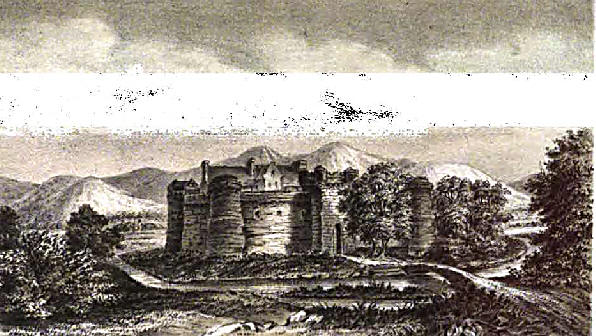
under the charge of a keeper,
whose duty it was to receive the victual, to distribute it among the baron's
retainers, and to sell or barter such portions of it as were required by the
cottars and craftsmen located in the barony. References are often made to
the ‘gar-nar,’ or ‘girnel,’ in the family documents and the Records of the
Baron Bailie’s Court. For instance, in the transactions of Anthony Murray,
factor to John, Earl of Wigton, for the half year ending Martinmas 1667, we
notice that he paid six bolls and three firlots of meal to William Thripland,
my lord's (garnar man’ in Biggar, being half a boll for every chalder of
thirteen chalders and nine bolls, which he did measure into the garaar, and
measure out the same again, and did uphold the measure. James Carmichael,
who was factor to William, Earl of Wigton, paid to the same William Thrip-land
4 ye soume of twentie pund Scots for his service in his Lordship’s giraal,
fra Martinmas 1675 to Martinmas 1676.’ The girnel at Boghall seems at that
time to have undergone a repair, as there is an entry in the factor’s books
of L.51, 8s. 8<L, paid ‘for wrught work and seives to the giraall, and lyme
to the house of Boghall, and leid to dress the windows.’
In the Records of the Baron’s
Court, we find that Bailie Alexander Wardlaw, on the 29th of July 1720,
‘decerns the haill tennents, feu-ars, and others, lyable to the Earl of
Wigtoun, to pay moulter and teind meall into the girnall, and any that hes
gotten out meall upon trust, to pay to John Gledstanes, giraall man, one
pund and fyve shillings Scots, for each boll, betwixt and teusday nixt,
under the pain of poynding.’ On the 28th of March 1747, Thomas Carmichael,
keeper of the girnel of Biggar, made complaint before Bailie Robert Leckie,
‘That sundrie of the Tennants, after grinding of their farm meall, doe allow
the same to ly in ye miln, or in their own houses, a considerable time,
without delivering the same into the garnell, by which means the meill is
lyable of being spoiled and damnified. Therefore, the Bailliflf enacts and
ordains, that, for the future, the haill fewars and tennants of the
barroneys of Boaghall and Biggar shall, immediately after their meall is
grand att the miln, at least, within fourty-eight hours thereafter, deliver
their farms into the garnell, and that under the penaltie of ten shillings
Scots for each undelivered boll, to be payed by the failziers to the said
Thomas Carmichael, as garnell keeper, and his successors in office.’
An opinion has long prevailed
at Biggar, and is referred to by Forsyth in his ‘Beauties of Scotland,’ that
the habitable part of the Castle was originally of greater extent than it
was in later times, and that it stood in the centre of the enclosed area. In
trenching the ground, to a considerable depth, some years ago, no distinct
trace of former buildings was, however, discovered; but this is certainly
not decisive evidence on the point, as the buildings may have all been
thoroughly removed. The deep morass on the south serving as a sufficient
defence, was evidently the cause why the mansion-house, at least in the end,
came to be placed in that quarter, and left unprotected.
The Castle of Boghall was, no
doubt, built at a remote period. The exact time, however, cannot now be
ascertained. David Fleming, second son of Sir David Fleming of Biggar, who
was killed at Long-hermonston in the spring of 1405, settled on some lands
in Renfrewshire, which he called Boghall, a name which he most likely
assumed out of respect to his paternal habitation. In an old book in the
possession of Mr James Watt, Biggar, there is the following entry:—
‘Note.—The Boghall Castle was built in the year of Christ 1492, by Malcolm
Fleming of Cumbernauld/ Little dependence can be placed on this assertion,
as it is unknown who made it, and is unsupported by any collateral evidence.
It is very far from unlikely, however, that it was rebuilt at that period.
It had certainly very much the appearance of having been built about the
time of James IV. or James V. It had a degree of spaciousness and elegance
that removed it considerably from the style of strongholds usually occupied
by the Scottish barons, and led to the opinion that it had been constructed
after the fashion of some of the large chateaux in France. Although not of
extraordinary strength, it seemed able, if properly garrisoned, to withstand
any attack, provided it was not made with heavy artillery. It must, for a
long period, have been a principal residence of the Fleming family; but in
the latter part of their history they seem to have given a preference to the
House of Cumbernauld, which, at one time, was also a fortified stronghold.
After the death of the last
Earl of Wigton, and the transference of the Biggar estates to the
Elphinstone family, in 1747, the Castle of Boghall was more and more
deserted. No repair was made on the buildings, and the consequence of course
was, that they began gradually to fall into ruin. Between 1773 and 1779,
when the sketch of the castle was taken, by John Clerk of Eldin, from which
the accompanying view of it has been engraved, it was then almost entire.
Captain Grose, whose name has been immortalized by Bums, visited Biggar in
1789, and also took a sketch of the Castle, which he afterwards published in
his work on the ‘Antiquities of Scotland.’ By that time it had evidently
undergone considerable dilapidation. The tower above the gateway had been
partially demolished, and some of the stones had been removed from the top
of the outer wall. In a view of it given in the ‘Scots Magazine* for October
1815, it appears by that time to have been entirely dismantled, and many
parts of the walls laid in ruins. The writer of a letterpress description of
the town of Biggar and its neighbourhood, in the same number of the
Magazine, says, in reference to the Castle, ‘It is in a state of rapid
decay, which, we are ashamed to understand, was accelerated some years ago
by the appropriation of a part of its materials to the erection of a dog-kenneL
It is still a ruin of considerable interest, and we would entreat the
proprietor to save it, and adorn the spot by surrounding it with planting.’
No attention was paid to this remonstrance; but, in 1821, Admiral Charles
Elphinston Fleming, the proprietor, on some account or other, caused workmen
to repair the walls of the projecting staircase, in the centre of the
habitable part of the Castle, and to cover it with a roof of slate.
When the entail of the Biggar
estate was broken in 1830, the farm of Boghall Mains, and the other lands
still belonging to the heir of the Fleming family in the parish, were
brought to the hammer. By some misunderstanding or mismanagement, the
remains of the Castle, a short time afterwards, were nearly all carried away
to fill drains and build dykes. The only parts left were the recently
repaired staircase, and a portion of two of the flanking towers. These
fragments, with a few trees, now stand—sad relics of a glory that has passed
for ever away. How desolate and solitary is the scene around; how different
from the days of feudal splendour! Now the ample court, the fosse, and the
very site of the buildings, have been torn up by the plough, and are covered
with the successive crops of the husbandman. Happily in our day a feeling of
veneration for our ancient buildings has sprung up; the writings of Sir
Walter Scott, and others, and the increased attention which has been paid to
archaeological studies, have deepened and extended this feeling, and caused
it to find practical manifestation in preserving our ancient and dilapidated
castles, abbeys, and cathedrals from further demolition, and sending
thousands and tens of thousands from all quarters to gaze on their time-worn
remains. The person who presumes to lay a violent hand upon them is liable
to receive very severe censure. We therefore cordially concur in the
following remarks, in a recent address on Archaeology, by Professor Simpson
of Edinburgh. (I solemnly protest,’ says he, ‘against the needless
destruction and removal of our Scotch antiquarian remains. The hearts of all
leal Scotsmen, overflowing as they do with a love of their native land, must
ever deplore the unnecessary demolition of all such early relics and
monuments, as can in any degree contribute to the recovery and restoration
of the past history of our country and of our ancestors. These ancient
relics and monuments are truly, in one strong sense, national property; for
historically they belong to Scotland, and to Scotsmen in-general, more than
they belong to the individual proprietors upon whose ground %they
accidentally happen to be placed.’ ‘ Let us fondly hope and trust,’ he
further adds, * that a proper spirit of patriotism, that every feeling of
good, generous, and gentlemanly taste, will ensure and hallow the future
consecration of all such Scottish antiquities as still remain—small
fragments only though they be of the antiquarian treasures that once existed
in the land.’ Many local poets have sung in doleful strains the demolition
of Boghall Castle. We have a number of their productions lying beside us,
and would gladly give some of them a place, did our limited space permit.
The engraved view of it which we have been enabled to give, will, no doubt,
make many other persons than poets deplore that it has been so thoroughly
swept away.
The blame of the destruction
of the Castle of Boghall is mainly to be attributed to the Elphinstone
family. It was they who left it to entire neglect, who failed to expend a
few pounds to keep it in a state of repair, who carried off a portion of its
materials to build a dog-kennel, and who sold it, without making the least
reserve as to its preservation.
When these men, whose
forefathers had built it, had lived within its walls, and made it memorable
by their presence and transactions, not only felt no veneration for it, but
actually hastened its destruction, we could scarcely expect that other
parties, into whose hands it might fall, would view it with feelings of
warmer attachment, or would expend their efforts and their means to preserve
it from further demolition. Its removal, however, is to be regretted, as it
was a noble feature in the landscape, and as the district has little to show
in the shape of antiquities, and little to invest it with interest and
attraction to strangers. We can only now indulge the hope, that efforts will
be made to preserve such fragments of it as still remain.
A few relics of the Castle
have been preserved. The gimel-door is in the possession of Mr Allan
Whitfield, agent, Biggar. An antique clock, which formed part of the
furniture of the Castle, and which was presented by a member of the Boghall
family, most likely by Lady Clementina Fleming herself, to Dr Baillie, who
flourished as a physician in Biggar about the middle of last century, is now
in the museum of Mr Sim at Coultermains. A huge key, which was found near
the ruins, and which is supposed to be the key of the great outer gate, was,
and perhaps still is, in the possession of Laurence Brown, Esq. of
Edmonstone.
Several camion bullets, which
appear to have been at one time part of the munitions of the Castle, or to
have been shot against it during some of the assaults which it sustained,
are in Mr Sim’s museum. A curious sword-blade, with a waved edged, is shown
in the Museum of the Society of Scottish Antiquaries, as having been found
at the Castle of Boghall. It was presented to the Society, by John Loch,
Esq. of Rachan, in 1829. In the letter which accompanied it, Mr Loch says
that the sword was presented to him by an old man, who assured him that it
was found in the ruins of BoghalL How far this man’s testimony may be relied
on, it is impossible now to say; but it seems to have been credited by Mr
Loch. Swords with waved edges were used in mediaeval times for the purpose
of making a greater impression on defensive armour than could be done by
those which had their edges straight. They acted, in fact, as a kind of saw,
being drawn with great force across a helmet or a coat of maiL The Boghall
sword, a cut of which is here given, is 32^ inches long, and has engraved on
it the word Mini, repeated four times on each side of the blade, and some
slight ornaments which very likely were trade marks.
BoghaU Castle, in a
historical point of view, is not so remarkable as some other strongholds
that could be named. We really know nothing of its early history. We cannot
say what scenes of joy and sorrow, of peaceful entertainment or tumultuous
outrage, it may have witnessed in remote times. We only begin to get some
notices of it after it had been comparatively deserted by the Fleming family
for Cumbernauld House. Still it is not altogether destitute of interest We
have good reason for believing that it was often tenanted by the Scottish
kings, in their frequent progresses through this part of the kingdom. It
was, along with the town and burgh of Biggar, and the acres lying
thereabout, erected into a barony, called the Barony of BoghaU, by a charter
from James V. in 1538. Malcolm Lord Fleming, in his testament executed in
1547, assigned it as the jointure house of his wife, Joan Stewart, in case
of her surviving him; and she was to receive the whole
1 insight,’ or furniture, except the artillery, which was to be the
property of his son and heir. It was besieged and taken by the Regent
Murray, and many years afterwards by Oliver CromwelL It was, during the
persecuting times, the jointure house of Anna Ker, Countess of Wigton, and
was made memorable by the conventicles held, under her auspices, within its
walls. The last garrison that it ever contained was placed in it by the
Government, to overawe the adherents of the Covenant in Tweeddale and the
Upper Ward.
A large number of documents
in the charter chest of the Wigton family refer to BoghalL We select one or
two specimens of the accounts of the domestic expenses of William, Earl of
Wigton, during his residence at the Castle, from a large mass of papers of a
similar kind. The first is a statement entitled—

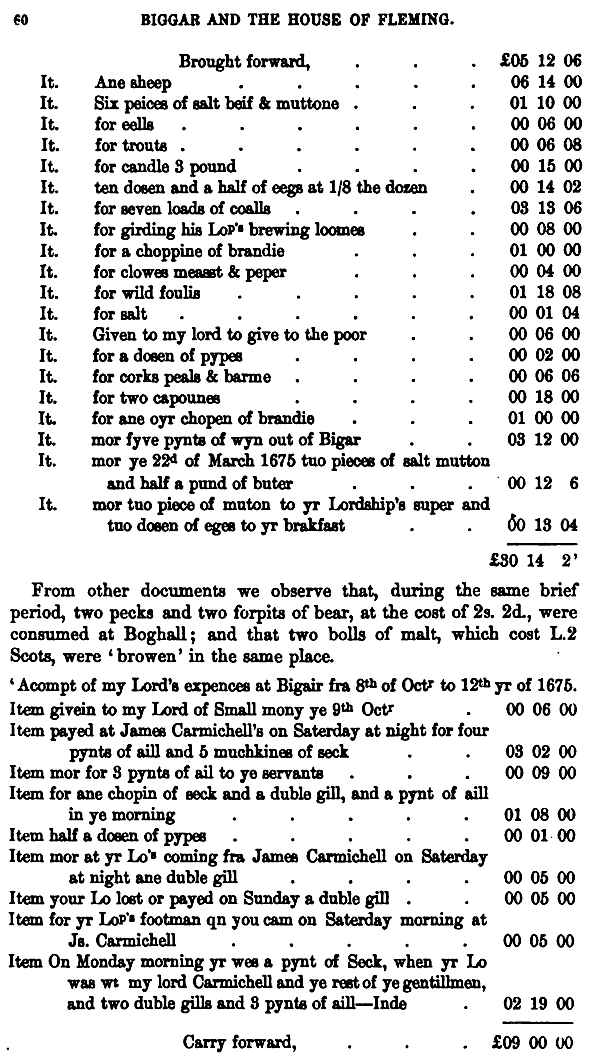
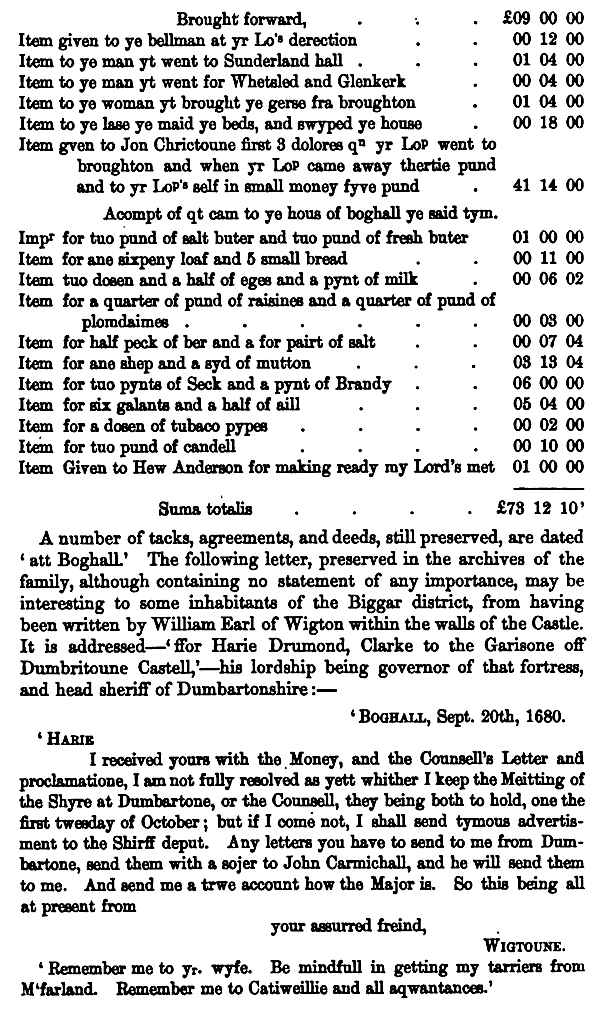
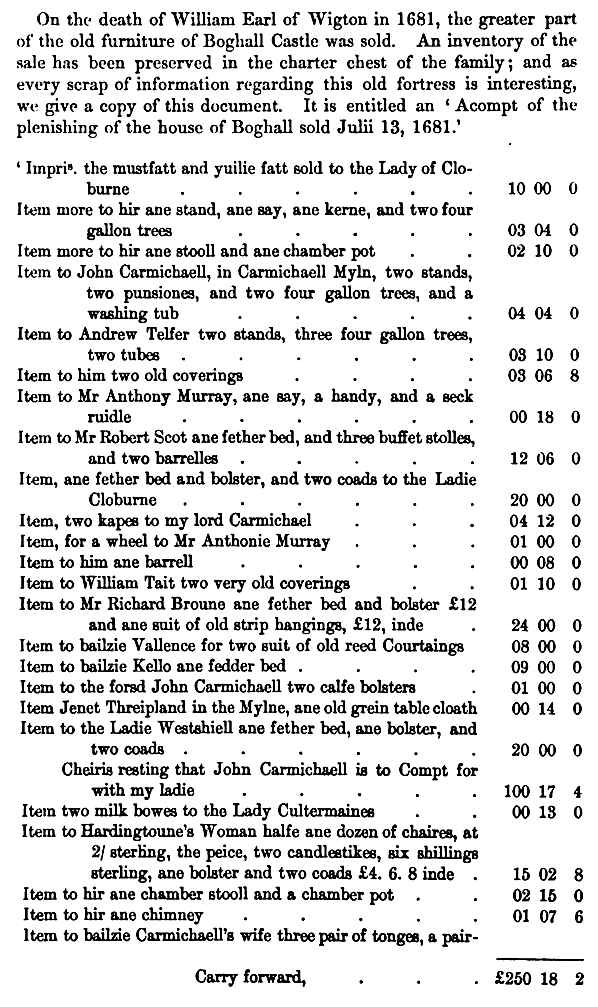
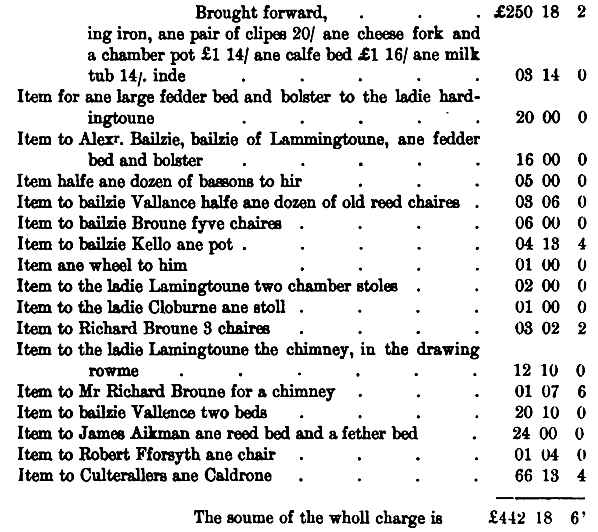 |

